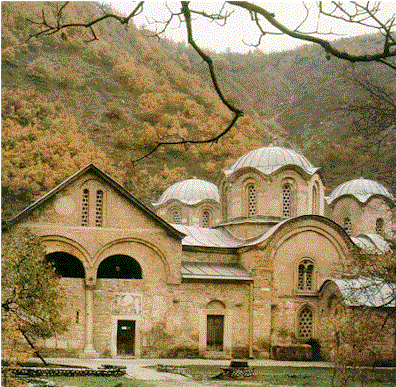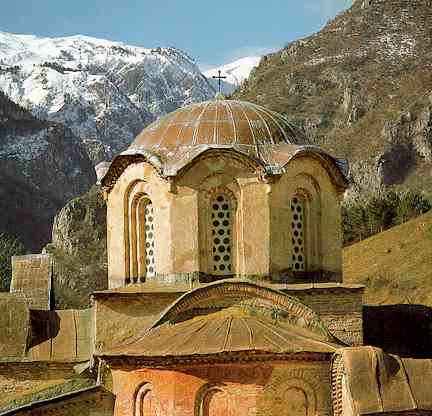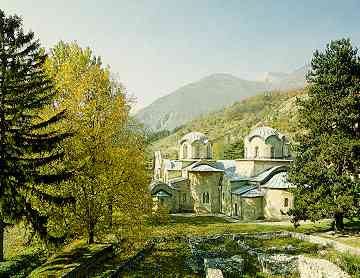[ Home ] [ Library ] [ Index ] [ Maps ] [ Links ] [ Search ] [ Email ]
The Saga of Kosovo
Part #7 (out of 7).
Back to: The history of Kosovo.
".....have no castles from our past, but churches and monasteries have been sown all over. The churches and
monasteries were like personal homes to everyone - rulers and shepherds, literate and illiterates, heroes and commoners."Kosovo is many diverse things to different living Serbs, but they all have it in them. They are born with it. The variety of meanings is easily explained by the symbolism and emotions that the word "Kosovo" embodies, clearly above anything that the geographic concept might imply. It is strictly Serbian, transcendental phenomenon.
 Monastery Church of Decani - The majesty and serenity of the largest of all Serbian medieval churches. It was built for King Stefan Uros III between 1327 and 1335. Decan contains more than 1,000 compositions, with an estimated 10,000 painted figures. There are more than 20 biblical cycles on the walls, from Genesis to the Last Judgment. This is the largest surviving iconographic complex ever created within the Byzantine sphere of influence. The Decani charter lists 2,166 agricultural homesteads and 266 stock-raising properties that were deeded to the monastery. Only 44 among them can be identified as ethnically Albanian.
|
||
 Map of Kosovo region showing the location of Serbian Churches and MonasteriesSome of the significant monasteries and Serbian churches in the Kosovo region are shown. Approximately 80 preserved churches built prior to 1459 are not shown. Approximately 60 ruins prior to 1459 are not shown. Approximately 30 churches built after 1459 are not shown. |
||
|
||
 Gracanica Monastery The last church built by King Milutin is certainly second to none among the serbian masterpieces. Built on Kosovo Field between 1317-1321, it was the see of the bishop of Lipljan, and ultimately it might have been planned as the final resting place of King Milutin. Among the standing saints and Christological compositions are the scenes of the Last Judgment and the portraits of King Milutin and his Byzantine-born Queen Simonide, daughter of Emperor Andronikos II. As in the case of many paintings of saints, the eyes of Queen Simonida are dug out by Albanians.For Serbs, Kosovo is holy ground. It is the cradle of our nation. It was the centre of Serbia's empire of the Middle Ages, at one time the strongest empire in the Balkans.
|
||
 Monastery of PecSerbia as a nation came into its own sometime in the 11th century, in the center of the Balkan peninsula, which at that time was within the vast realm of the mighty Byzantine Empire. |
||
|
|
||
 - Monastery of Pec- the center of Serbian Orthodox Christendom was the monastic complex at Pec, most often referred to as the Patriarchiate. The complex itself consists of several churches, chapels, and a large outer narthex, all attached and forming an inseparable unit. The oldest Church of the Holy Apostles, built by Archbishop Arsenije in the period between 1235-1250. Some of the original frescoes are still preserved.To the north, Archbishop Nikodimus added the Church of Saint Dimitrije during the years 1316-1324. The fresco ensemble is almost completely preserved. The images are signed in Serbian, while the painter left a signature in Greek in the apse of the church.To the south, the famous Serbian Archbishop, writer and architect, Danilo II, in 1330 added the church dedicated to the Virgin.
Monastery of PecThe Serbian People began to formulate their spiritual identity during the are of the Holy Brothers Cytil and Methodius (9th century), and their 5 disciples who followed (10th century). They are considered the first baptizes and enlighteners of the Serbs, as well as the other Slavs.The fruit of their work, harvested for some 2 centuries from Byzantium/Bulgaria to the Adriatic, included the gradual Christianization of the Serbs both nationally and individually, the appearance of the first ascetics and saints among the Serbs, and the first monuments of Serbia's spiritual and secular cultures.The preference for spiritual values became an inseparable part of the Serbian national soul, as well as its lifeblood in the early stages of its history.
|
|
|
 Monastery of Pec
|
||
In contrast to all of the Serbian historical monuments in Kosovo, there is not even one that is Albanian. |
||
 Milesava Monastery - in the period between 1544-1557 the
Mileseva Monastery becaome a "publishing house", printing on its own presses
numerous liturgical books. The popularity of these productions among Slavs was
considerable, and some reached as far as Russia. In return, some gifts were sent from
Russia to the monastery. For example, still preserved in the monastic treasury is a
chalice donated by Tsar Ivan the Terrible in 1558.
Milesava Monastery - in the period between 1544-1557 the
Mileseva Monastery becaome a "publishing house", printing on its own presses
numerous liturgical books. The popularity of these productions among Slavs was
considerable, and some reached as far as Russia. In return, some gifts were sent from
Russia to the monastery. For example, still preserved in the monastic treasury is a
chalice donated by Tsar Ivan the Terrible in 1558. 

